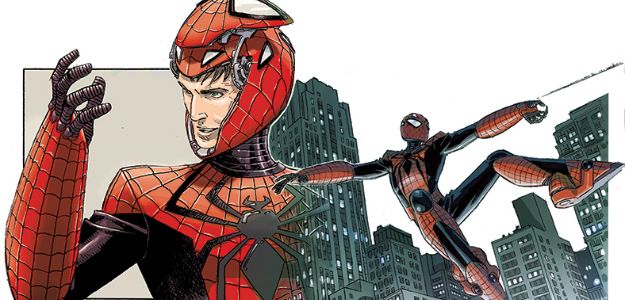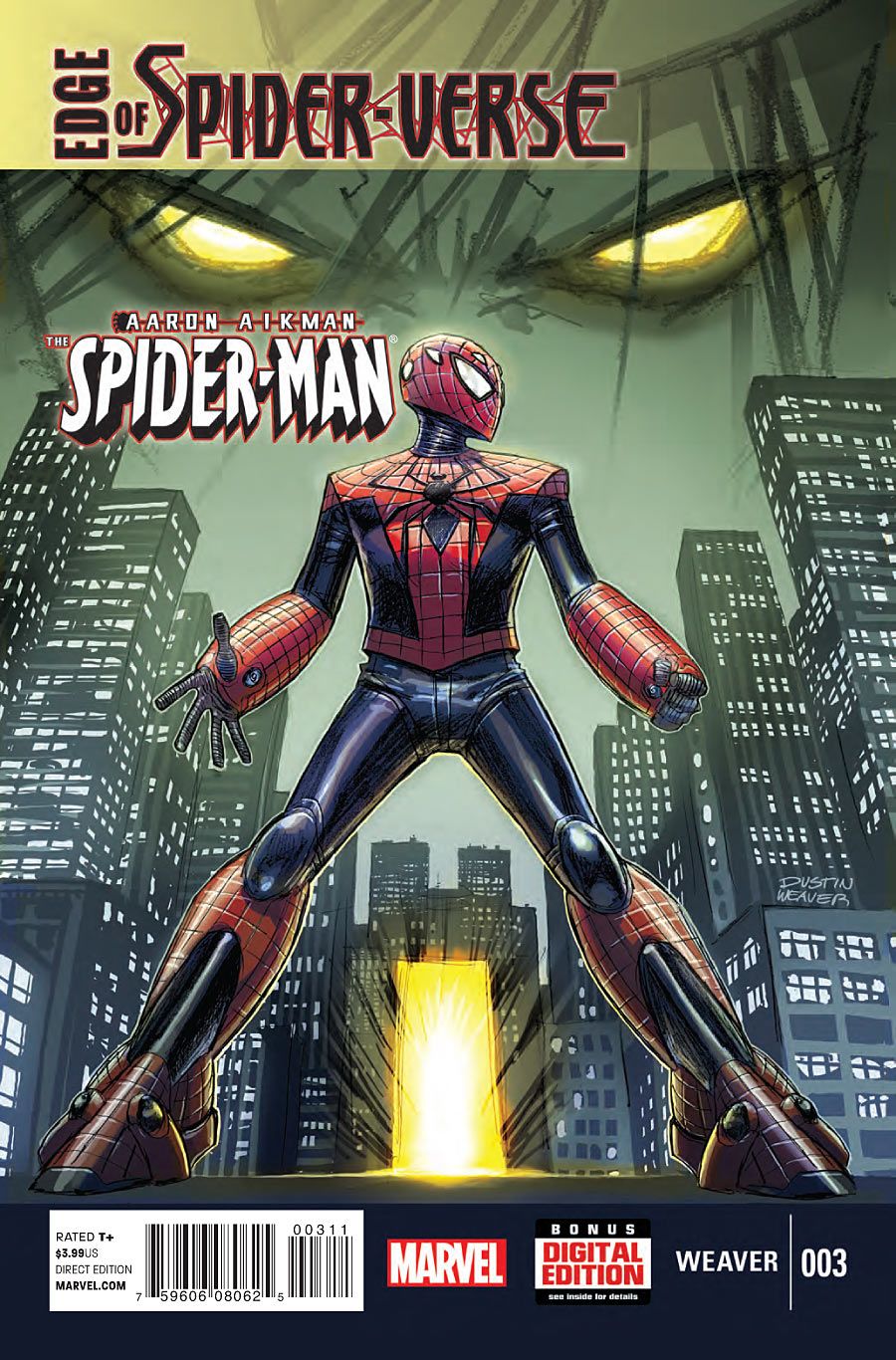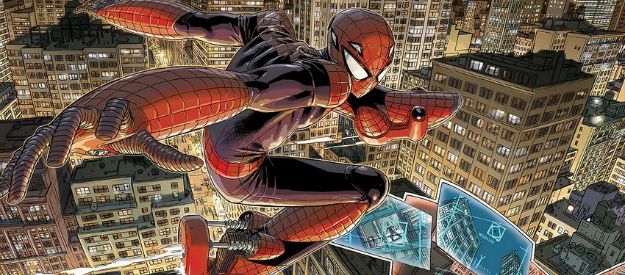Anyone who read my Best of 7 piece from Sunday on Edge of Spider-Verse #2 likely got the impression I'm eager to see more about the Spider-folks from other universes. On Wednesday readers will get a chance to read Dustin Weaver's Edge of Spider-Verse #3 starring Dr. Aaron Aikman, Spider-Man.
Weaver chatted with me about the one-shot he wrote, drew and colored for Marvel, and afterward we turned to his ongoing webcomics Sagittarius A* and Amnia Cycle.
Tim O'Shea: How early in the design of this Spider-Man did you realize he had to have jumping boots?
Dustin Weaver: The idea behind the Aaron Aikman Spidey is that he's simply a reimagining of Spider-Man. I wanted to take the idea of the "real" Spider-Man and filter it through my own sensibilities. The boots are maybe a good example of what I mean.
Aaron Aikman has almost all the same powers as Peter Parker. He has the strength, the agility and the ability to crawl on walls. He's also smart like Peter. Smart enough to have created web shooters. I figured, why would his scientific inventiveness stop there? Why not other technological elements? That's where the idea for the jumping boots comes from.
For me, the boots help compensate for the fact that web-shooters, if you are thinking of them as a technology in even a remotely realistic way, would probably be a demanding and not always reliable piece of machinery. I imagine Aaron's web-shooters require constant maintenance and often fail. Also, he only has a limited amount of webbing solution. So, shifting his reliance from the web-shooters to the boots as a mode of conveyance, made sense to me. Though the boots are also an advanced piece of technology, they are certainly more simple and probably more reliable.
Speaking of the design, what other elements of the costume were you pleased to incorporate?
Spider-Man, the real Spider-Man, is maybe my favorite superhero design. It's a great design! To be honest, I didn't want to stray too far from that look for the Aaron Spidey. I basically took that Spider-Man look and blended it with a more science fiction feel. So giving him a helmet, making the costume look a little more like biker leathers, and giving him the large boots and web-shooter gauntlets, making him reminiscent of Mega-Man, all push the look towards the sci-fi.
The helmet idea actually came about before I knew I'd be making a sci-fi Spidey. I've always liked when Spider-Man is drawn with no facial feature definition showing through his mask. When his nose isn't sticking out. When it's just a smooth egg like shape. You know? So, just in sketching the real Spidey I came up with the idea of making his mask more like a smooth helmet.
In the preview that ran recently in CBR, the pages feature trading cards for certain super-villains -- this is clearly an homage to past trading cards Marvel has done. Could you discuss what prompted you to include them, was it a short-hand way of introducing more character background to the story in an entertaining way?
I was definitely wanting a fun way of fleshing out the universe and relay exposition. It occurred to me that creating trading cards in the comic would serve that purpose perfectly. Then I immediately realized that I could recreate the Marvel series 1 and 2 cards, which I could only do in a book for Marvel. This idea was really exciting to me. In a way, the series 1 and 2 Marvel cards are what got me into comics. Those and the Jim Lee X-Men cards are very nostalgic for me.
Also, recreating those cards is an idea that involves every part of making a comic. They have to be written, drawn, colored, and lettered in just the right way to properly capture them. It's something that I believe I only could have pulled off by doing everything myself.
I wish I could have done more with the cards.
Was Dr. Aaron Aikman what came with the project, or did you concoct the name? The alliterative element does Stan Lee proud, I would say.
Everything about Aikman came from me. His name literally just came from me repeating the word arachnid in my mind until it started resembling a name like Aaron Aknid. I made it Aaron Aikman. It still sort of sounds like arachnid. Sort of. And yes the alliteration is inspired by Stan Lee, but I like how the sounds of the name Aaron Aikman kind of undermine the punch of a Stan Lee-esque alliterated name. Names like Peter Parker, J. Jonah Jameson and Otto Octavius all have a kind of strength. The hard consonant sounds give them some punch. The name Aaron on the other hand is airy and soft, and the name Aikman, sounding like "ache-man," suggests weakness. I like how it seems to undermine the power of an alliterated name. It kind of points to a philosophy that I think is an undercurrent in this story.
Had you been campaigning to write for Marvel in addition to your art duties, or was this something they suggested?
I've always wanted to be a writer/artist. I think that it's something that has been clear to most editors I've worked with, but I haven't pushed too hard to write for Marvel. There was a short period where I was discussing with them the possibility of doing a Wolverine story that I would write and draw, but other things took priority. And there have been a few places on S.H.I.E.L.D. where Hickman's scripts left me some room to create some story beats, but primarily my writing ambitions are for my own creations.
I wrote a one-shot Bebop & Rocksteady for IDW and I've been writing and drawing two web comics. I think those helped in landing me this gig.
Who is editing you, and how beneficial was it to work with him on the story?
The editor on Edge of Spider-Verse is Nick Lowe, who is always great to work with. Nick was the guy who first got me work at Marvel and I've worked with him for a long time first on some X-Men books then on S.H.I.E.L.D. Knowing that I've wanted to do more writing, he came to me with the this Spider-Verse job, which I jumped at.
Nick was open to whatever I wanted to do with this story. He was able to engage with what I sent, see what I was aiming for, and offer feedback that was helpful in strengthening it. He's really good at his job!
It's time-consuming if you are also the writer and artist, of course, but if you had your preference would you always color your art?
I really enjoy coloring. It's great fun, and bringing an image that is in my head all the way to its complete state is truly satisfying for me. When I'm coloring my own work I can pull back on the amount of rendering I put into the line art. I can relax with the drawing because I know exactly how I'll handle the piece when it's time to color it.
If I'm being honest, I would prefer to do everything, write, draw, and color. Some lettering too, like sound effects … I don't think I'm a control freak, I just think I enjoy all of these things. I enjoy the art of comics, which is the art of static pictures and words working together. There is only so much you can do to explore this art form if you are only creating one part of it.
What interests you most about exploring the Spider-Verse?
I was very interested in working on the Edge of Spider-Verse series. In this series each of the creative teams had the chance to create a wholly unique universe. It was an opportunity to put forth your own personal creative vision, while utilizing the appeal and popularity of Spider-Man, an icon of popular culture. I can say that, though this is a Marvel comic, it is very much "me". Being able to have that sense of ownership (creatively, not legally) over the comics you work on makes working on them immensely satisfying.
Looking at the page 8-9 spread I'm struck at the cityscape behind Aikman/Spider-Man (shown above). Am I right in thinking you love to draw buildings?
Honestly, I love drawing everything. It's hard for me to think of anything I don't like to draw. But it's true that I do place a high value on comic art that has well-realized settings. I like it when the world feels like it's alive and that it exists outside of the story you are reading. For me, believing in that setting helps me believe in the story I'm reading. Also, when you are drawing detailed settings with specific, non-generic, design elements you can use those details to strengthen your storytelling. I think specificity in all design work helps with storytelling.
If response was strong enough, would you be open to telling more tales of Aikman/Spider-Man?
Yeah! Sure I would. If I could, I'd like to tell the first Aaron Spider-Man story which would include the villain RedEye, whom you saw in one of those trading cards. I barely touch on Aaron's and RedEye's origin stories in Edge of Spider-Verse. In my mind there is a lot more to that story.
I would be remiss if I did not give you a chance to discuss your webcomic, Sagittarius A*? How did you come up with the project -- and what's the significance of the name?
Oh, thanks for asking. I currently have two webcomics, Sagittarius A* and Amnia Cycle. They are both science fiction stories set in space and have fighter pilot protagonists, but other than that they are quite different.
The title Sagittarius A* refers to the location of the super massive black hole at the center of the Milky Way, and it's where the protagonist, Linus Rad, is heading. It's set in the aftermath of a galactic war with the sentient robot race humanity created. For mysterious reasons concerning his dead father, Linus is making a long journey to the center of the galaxy. As he goes deeper we learn more and more about what put Linus on this mission, the lies Linus lives with and the dark secrets of his fathers scientific experiments.
Amnia Cycle is an improvised story, meaning I'm writing it as I go. I have an end point for the story in mind, but with each scene there is the possibility that even I can be surprised by what happens. It's really the most fun I've had working on anything ever.
The story of Amnia Cycle centers on a pilot named Tara Donnia who goes AWOL in the middle of a war with aliens to help a strange woman named Amnia escape. When Amnia mysteriously vanishes it sends Tara on an adventure into an area of space called the Shadow Zone to look for answers. What she finds there is that the life she's been living isn't the one she is meant for.



